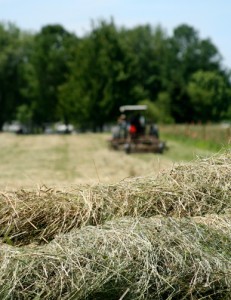There are many reasons why you might have to look out hay alternatives, from equine allergies, to a shortage of quality hay, so we take a look at what’s on offer.
Forage is an essential part of the horse’s diet, and when it is in short supply and good quality fibre is even harder to find, the bagged alternatives are an option worth considering for many horse owners. While most people know that fibre is an incredibly important part of the horse’s diet, many tend to think of the fibre options as just either long and green or maybe preserved and therefore slightly brown, (grass, hay, straw!). Don’t forget that chaffs and even some concentrate feeds are also important sources of fibre, so keep a look out for high fibre products if hay is not working out for you.

Ryegrass haylage: Made from ryegrass or a selection of ryegrasses to provide higher protein and energy levels. Ideal for competition horses and ponies, hunters, heavy horses, youngstock and breeding stock. It can also be fed to help horses gain weight and improve condition.
High fibre haylage: Made from ryegrass that has been allowed to mature before harvesting to attain higher fibre, lower protein and lower energy levels. Suitable for riding and pony club horses and ponies, native ponies, veterans and those that are resting, convalescing or are laminitic.
Timothy haylage: Made from timothy grass which is higher in fibre and lower in protein than many other grasses making it suitable for leisure horses and ponies, native ponies, veterans and those resting, convalescing or laminitic.
Alfalfa can also be used to make haylage and as a legume has higher levels of protein, digestible fibre, energy, calcium and vitamins than grass. The higher nutrient levels make it suitable for horses in hard work, poor doers, veterans and show horses.
Oat straw chaffs are the standard chaffs known to most horseowners and suited to all horses but particularly those in light work. They are available with various coatings – usually molasses or soya oil – and with various additions such as garlic, herbs, apple or carrots.
Alfalfa chaffs include chopped dried alfalfa with various coatings including soya oil and molasses. They are generally suitable for horses that are in more work or those that need to gain condition.
Alfalfa/oat straw/grass blends with different coatings are particularly popular as they tend to suit most horses, including leisure horses that are only in light work, and those that are on a diet.
High temperature dried grass chaffs are usually suitable for horses in light to medium work. Some of these are available without coatings, unlike most alfalfa chaffs.
There are several ‘Hoof chaff’ products available which are aimed at laminitic horses and ponies providing a fibre feed balanced with vitamins and minerals which actually suits a wide variety of horses as no other feeds or supplements are required.
This is available as the traditional nuts or shreds, as well as the newer quick-soak products, and is a great way of adding hydrating fibre to a horse’s diet, particularly in the winter when his diet will typically be drier.
As horses age it becomes increasingly difficult for them to manage hay to the point where they will actually refuse to eat it. Reduction in fibre intake can often explain why older horses lose weight, get loose droppings and suffer with colic more so feeding fibre that old horses can chew is vital. Recent studies have shown that the hay was refused by the horses with poor dentition significantly more often than a combination of high temperature dried grass and alfalfa, while a soaked alfalfa and sugar beet product wasn’t refused at all.
In practice, it is important to ensure that horses with poor dentition have sufficient time to eat the feed they are given and not to make the assumption that if they haven’t eaten it in the usual time that they are just not hungry. Even when fed ad lib hay, those with poor dentition will consume less which is likely to result in a drop in condition. Changing to a forage source they can eat more easily is essential to maintain fibre intake, and thereby maintain healthy gut function.
Providing a horse with poor dentition with a soaked fibre feed can significantly increase the amount of fibre they are able to consume, but as the fibre in soaked products tends to be ground to smaller particles making it easier to chew, it is also likely to pass through the digestive system more quickly. It is therefore beneficial to provide short chopped fibre alongside to maintain normal gut function.
In most circumstances horses and ponies benefit from eating fibre in the form of long or chopped forage. However, there are situations where this is not possible and times when a low calorie cube is desirable. High fibre cubes are formulated to be very low in starch and sugar, and can usually be fed dry or quick-soaked. As with all fibre, the digestion of these cubes will lead to a ‘warming’ effect in the hindgut, which is very beneficial to horses, especially veterans, in cold weather. Such cubes are ideal as a source of fibre for elderly horses and ponies with poor or no teeth. The cubes can be quickly soaked to a mash, and most are also suitable as a safe, very low-calorie feed for horses and ponies prone to laminitis, as a very low-calorie feed for good-doers, as a reassuringly ‘non-heating’ feed for sharp or ‘fizzy’ horses and as a non-stimulating feed to give when horses are being ‘broken-in’ or moved.